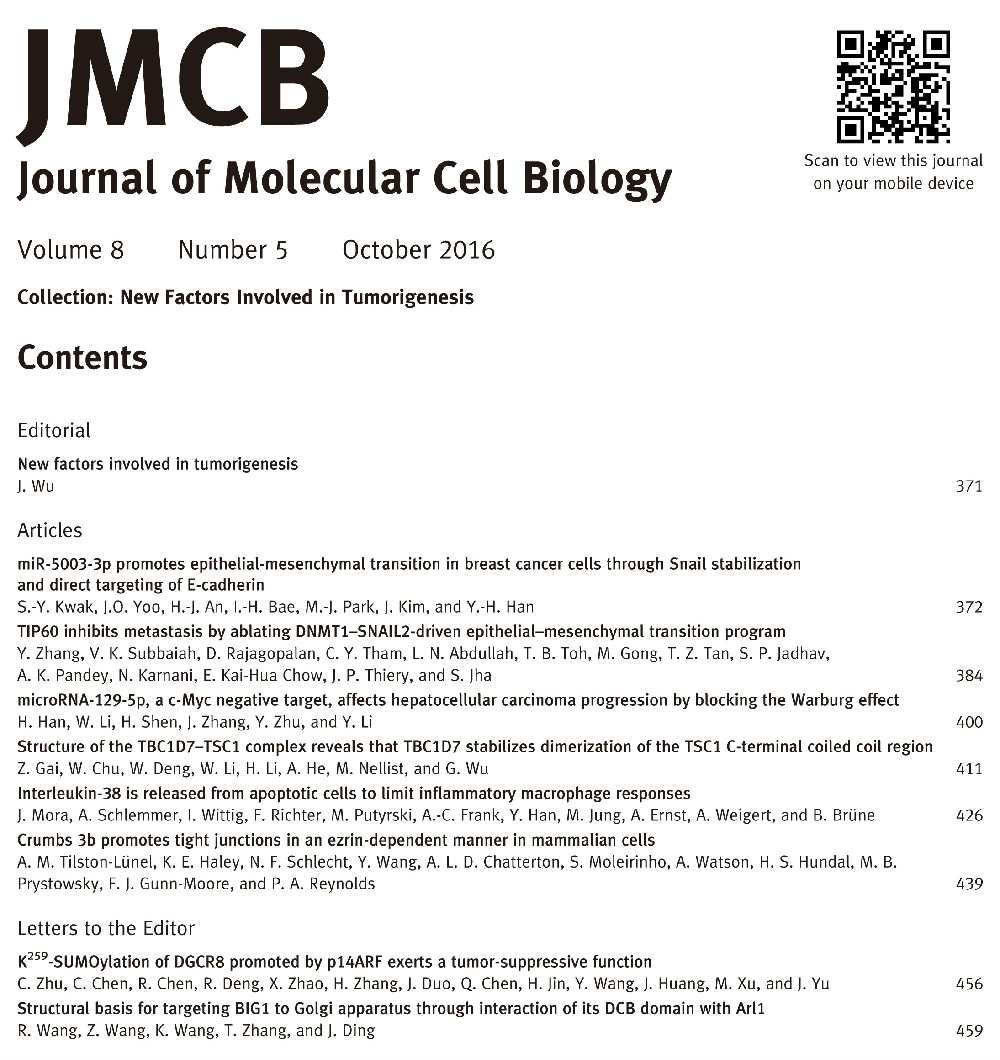博文
JMCB新刊(New Factors Involved in Tumorigenesis)上线啦!
||
JMCB-2016年最新一期文章上线啦!
这期COLLECTION的主题为New Factors Involved in Tumorigenesis
具体内容见: https://academic.oup.com/jmcb/issue/8/5

本期刊物导读:
Cancer biology and the related translational researches are among the topics of the most interest to the life science society, including the general audience of JMCB. Several issues of JMCB have been published to report the progresses in various areas of cancer biology (Wu, 2013a, b, 2015). This issue includes more research papers presenting new molecular factors involved in either positive or negative regulation of tumorigenesis, which might contribute to developing new biomarkers or intervention targets for cancer therapy.
During the metastasis of solid tumours such as breast cancer, a critical step for metastatic initiation is the special biological process called epithelial-mesenchymal transition (EMT), in which the polarized immotile epithelial cells are converted into motile mesenchymal cells. In the first article of this collection, Dr Han's laboratory identified a microRNA, miR-5003-3p, as a positive regulator of EMT based on a functional screening on breast cancer cell lines. The authors showed that miR-5003-3p induced the EMT features in the breast cancer cells by upregulating the EMT-promoting transcription factor Snail and downregulating the transcriptional repressor E-cadherin. They further revealed that miR-5003-3p could directly increase Snail stabilization through targeting MDM2 and indirectly increase Snail stabilization by inhibiting E-cadherin. On the other hand, Dr Jha's group uncovered a negative regulator of EMT, HIV-Tat-interacting protein of 60 kDa (TIP60). The authors showed that upregulation of TIP60 induced the destabilization of DNMT1 and inhibited the function of SNAIL2. They further demonstrated that the absence of TIP60 resulted in the recruitment of DNMT1 to the promoters of SNAIL2 target genes and consequently the increase of DNA methylation on their promoter region. In addition, TIP60 was found to be significantly downregulated in breast cancer patients with poor overall survival and disease-free survival prognoses, suggesting that TIP60 could be a prognostic biomarker of breast cancer progression and stabilization of TIP60 could be a promising strategy for breast cancer treatment.
Another article in this collection by Dr Li's laboratory also reported a microRNA, miR-129-5p, as a negative regulator of tumorigenesis. The authors demonstrated that miR-129-5p could inhibit the expression of the mitochondrial matrix protein pyruvate dehydrogenase kinase 4 (PDK4), leading to inhibition of glycolysis, retarded tumour growth, and impaired lung colonization. They further showed that the miR-129-5p levels negatively associated with clinical stages in human hepatocellular carcinoma (HCC), while overexpression of miR-129-5p suppressed the diethylnitrosamine (DEN)-induced hepatocarcinogenesis in mice, suggesting that miR-129-5p might be of therapeutic importance for HCC.
Furthermore, the study in Dr Yu's laboratory indicated that DGCR8, a factor involved in microRNA biogenesis, could function in tumour suppression. The authors demonstrated that such tumour-suppressive function of DGCR8 required SUMOylation on the site of K259, while their previous work indicated that SUMOylation on K707 of DGCR8 promoted tumorigenesis. They further showed that the nuclear localization of DGCR8 might be maintained by K259-SUMOylation, which was promoted by p14ARF. This work indicates that modifications on different amino acid residues of the same protein could result in either promotion or suppression of tumorigenesis.
References
Wu, J. (2013a). New way to tumor therapeutics. J. Mol. Cell Biol. 5, 1–2.
Wu, J. (2013b). DNA damage and tumorigenesis. J. Mol. Cell Biol. 5, 155–156.
Wu, J. (2015). New insights into the regulation of tumorigenesis. J. Mol. Cell Biol. 7, 91.
https://blog.sciencenet.cn/blog-1045694-1007977.html
上一篇:[转载]陈剑峰研究组揭示妊娠期胆汁淤积症患者胎盘炎性反应的发生机制
下一篇:JMCB Special Issue Available (Vol. 9, No. 1)